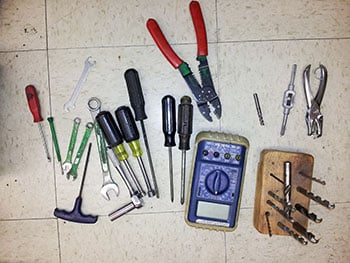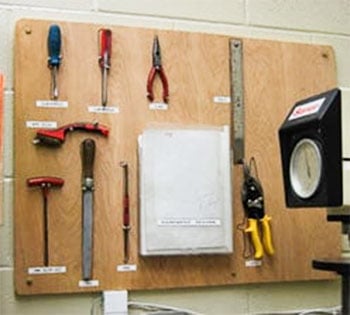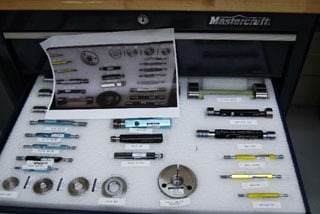LEAN Manufacturing & 6S At VMAC
VMAC LEAN Series: 5S Program
LEAN Manufacturing is part of VMAC’s continuous improvement culture, intended to maximize value and minimize waste. Ongoing improvements make for a healthier organization and allow us to work more efficiently and pass additional value on to our customers.
The 6S methodology is a valuable tool in VMAC’s LEAN culture, developed to improve organizational efficiency through 5S + Safety.
The term 5S originates from five Japanese words starting with the letter S: Seiri, Seiton, Seiso, Seiketsu, and Shitsuke. Translated, Seiri means tidiness, Seiton means orderliness, Seiso means cleanliness, Seiketsu means standardization, and Shitsuke means discipline.
To stay consistent with the five S’s, the English terms have been modified to Sort (Seiri), Set in Order (Seiton), Shine (Seiso), Standardize (Seiketsu), and Sustain (Shitsuke).
| Original | Japanese Translation | English Variation |
| Seiri | Tidiness | Sort |
| Seiton | Orderliness | Set In Order |
| Seiso | Cleanliness | Shine |
| Seiketsu | Standardization | Standardize |
| Shitsuke | Discipline | Sustain |
The 6S method adds Safety to the 5S methodology, reflecting the importance of prioritizing safety in everything we do.
Step 1: Sort (Seiri)

The first step in the 5S methodology is to Sort. This means sorting through each item in the area, keeping only what is needed. Getting a workspace sorted is important because it helps spot and address any problems with efficiency right away.
Each sorted item should be inventoried and classified. It’s important to be honest about each item’s purpose as it can be a slippery slope to save items just because one day they might be needed.
At VMAC, each coworker is responsible for sorting their workspaces, and teams work together to tidy shared spaces.
While sorting, it’s routine to “red tag” items that are not needed in the area or have no home. Each department at VMAC has its own Red Tag Area where these items are left for 30 days. During this 30-day period, potential owners are welcome to review the items to see if they can be repurposed. After 30 days, the items are recycled, auctioned, or disposed of.
Step 2: Set In Order (Seiton)
 Now that an area’s items have been sorted, it’s time to Set the workspace in order, and find a specific place for each item. Items should be identifiable, easy to access, and set so that anyone can tell where to return something. Items that are not frequently used can be stored out of the way.
Now that an area’s items have been sorted, it’s time to Set the workspace in order, and find a specific place for each item. Items should be identifiable, easy to access, and set so that anyone can tell where to return something. Items that are not frequently used can be stored out of the way.
At VMAC, labels and tool shadow boards are common methods to keep items organized.
Labels are placed on the outside of cabinets so that coworkers are able to see where items are stored without having to search through shelves and storage areas. In the shops, tool shadow boards provide a visual aid to quickly identify missing items and show where items should be returned.
Step 3: Shine (Seiso)
After a workspace has been sorted and set in order, it’s time to Shine it up. This means keeping the area clean and in ready-to-use condition.
At the end of the day each area should be returned to the clean state it was in at the start of the workday. While cleaning, VMAC coworkers take the time to inspect machines, equipment, and tools to ensure everything is in good condition.
In the shops and offices, each coworker is responsible for keeping their workspace, shared equipment, and common areas clean.
Step 4: Standardize (Seiktsu)
Now that the area has been organized and cleaned, it’s time to Standardize—maintain uniformity and follow best practices in the workplace.
Visual aids, simple work instructions, and documentation help ensure standardization. For example, every VMAC department has a 5S schedule posted to show who’s in charge of keeping communal areas clean and tidy. The schedule also specifies if each task is to be completed daily, weekly, bi-weekly, or monthly.
At VMAC, standardization is ongoing as best practices evolve with experience and changing requirements.
Step 5: Sustain (Shitsuke)

The 5S methodology is an ongoing commitment to organization and efficiency, and the final step involves Sustaining progress made, even as new equipment, products, and policies are implemented.
Continuing to review systems helps prevent new challenges from occurring. For example, a common challenge is maintaining a clutter-free workspace. Once an area has been 5S’d, there’s often lots of free space which can attract new clutter. For this reason, constant vigilance is the key to 5S at VMAC.
As part of the Sustain step, VMAC coworkers perform routine 5S audits, auditing departments that are not their own to allow for a fresh set of eyes to identify opportunities. LEAN coaches are also available to help guide coworkers in this exercise.
5S wins are celebrated with before and after photos that show off each department’s progress, and success stories are shared in the quarterly VMAC newsletter, inspiring coworkers to continue their commitment to LEAN.
Step 6: Safety
At VMAC, we place the safety of our coworkers and products above all else. Therefore, it only makes sense that we also consider safety during our continuous improvement initiatives. The Safety step encourages us to actively identify hazards and create preventative controls that reduce risks.
VMAC rewards coworkers with a chance to win prizes every time they submit a near miss or safety improvement suggestion, and a couple of these safety suggestions are shared at every all-coworkers meeting. In addition, VMAC only blames processes—never people—resulting in a no-risk safety culture that everyone can engage with.
The 6S methodology allows VMAC to operate more efficiently, while embracing beneficial change. It maximizes value, minimizes waste, and allows VMAC to manufacture the best mobile air compressors in the world.
Learn more about VMAC’s company culture!
